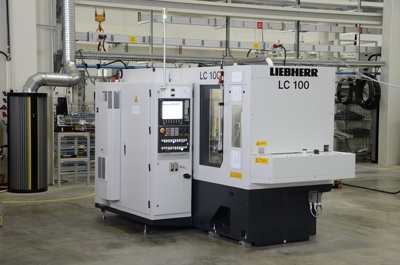
"With a rapid machine loading and unloading capability, the Liebherr LC 100 can achieve chip-to-chip times of three seconds, impressive for a machine with only one work table and still meet gear quality requirements," reports Dr.-Ing. Oliver Winkel, head of application technology at Liebherr-Verzahntechnik GmbH.
The Liebherr LC 100 is designed to machine small, mass-produced components and conventional automatic gearbox applications, such as planetary and sun gears. The fast swivel loader assures short chip-to-chip times and therefore high productivity. Set-up flexibility is enhanced by exchangeable quick-change gripper inserts requiring no tools.
Toolmaker Gebr. Saacke GmbH, Pforzheim, Germany, uses the LC 100 to machine carbide worm wheel hobbing cutters. The machine provides a range of benefits, such significantly higher hobbing speeds are feasible to minimize machining times. Furthermore, the increased rigidity and cutting-edge reliability of the Saacke carbide tools delivers a higher level of surface quality than conventional HSS tools. In addition, the hardness and the edge strength of the carbide tools support long tool life.
Winkel explains: "The great results achieved are based on joint development and testing work performed by both Liebherr and Saacke. Our close worm wheel hobbing machine partnership is based on each company's core skills and enables users to manufacture worm gearing with good roll performance characteristics and optimum power transmission in the shortest possible time."
The engineering platform for this is provided by Liebherr machines with a high degree of reliability and tools with precision profile geometries. When looking at performance, another important point needs to be made. Because tools with a diameter of as little as 20 to 30mm are comparatively thin in relation to length, conventional tools would tend to vibrate. Given its high modulus of elasticity, carbide is far less prone to vibrate and rattle. Hobbing speeds can be increased significantly. At tool diameters of between 20 and 30mm and cutting speeds of more than 250 m per minute, hobbing speeds of more than 3,000 to 4,000 rpm can be achieved.
According to Winkel, "Not many machines are capable of that speed range. Users can exploit the LC 100's technological potential using carbide tools. The machine enables us to achieve cycle times of approximately 5 seconds, or just 20 percent of the time such a process usually takes."
Related Glossary Terms
- hardness
hardness
Hardness is a measure of the resistance of a material to surface indentation or abrasion. There is no absolute scale for hardness. In order to express hardness quantitatively, each type of test has its own scale, which defines hardness. Indentation hardness obtained through static methods is measured by Brinell, Rockwell, Vickers and Knoop tests. Hardness without indentation is measured by a dynamic method, known as the Scleroscope test.
- high-speed steels ( HSS)
high-speed steels ( HSS)
Available in two major types: tungsten high-speed steels (designated by letter T having tungsten as the principal alloying element) and molybdenum high-speed steels (designated by letter M having molybdenum as the principal alloying element). The type T high-speed steels containing cobalt have higher wear resistance and greater red (hot) hardness, withstanding cutting temperature up to 1,100º F (590º C). The type T steels are used to fabricate metalcutting tools (milling cutters, drills, reamers and taps), woodworking tools, various types of punches and dies, ball and roller bearings. The type M steels are used for cutting tools and various types of dies.
- modulus of elasticity
modulus of elasticity
Measure of rigidity or stiffness of a metal, defined as a ratio of stress, below the proportional limit, to the corresponding strain. Also known as Young’s modulus.






